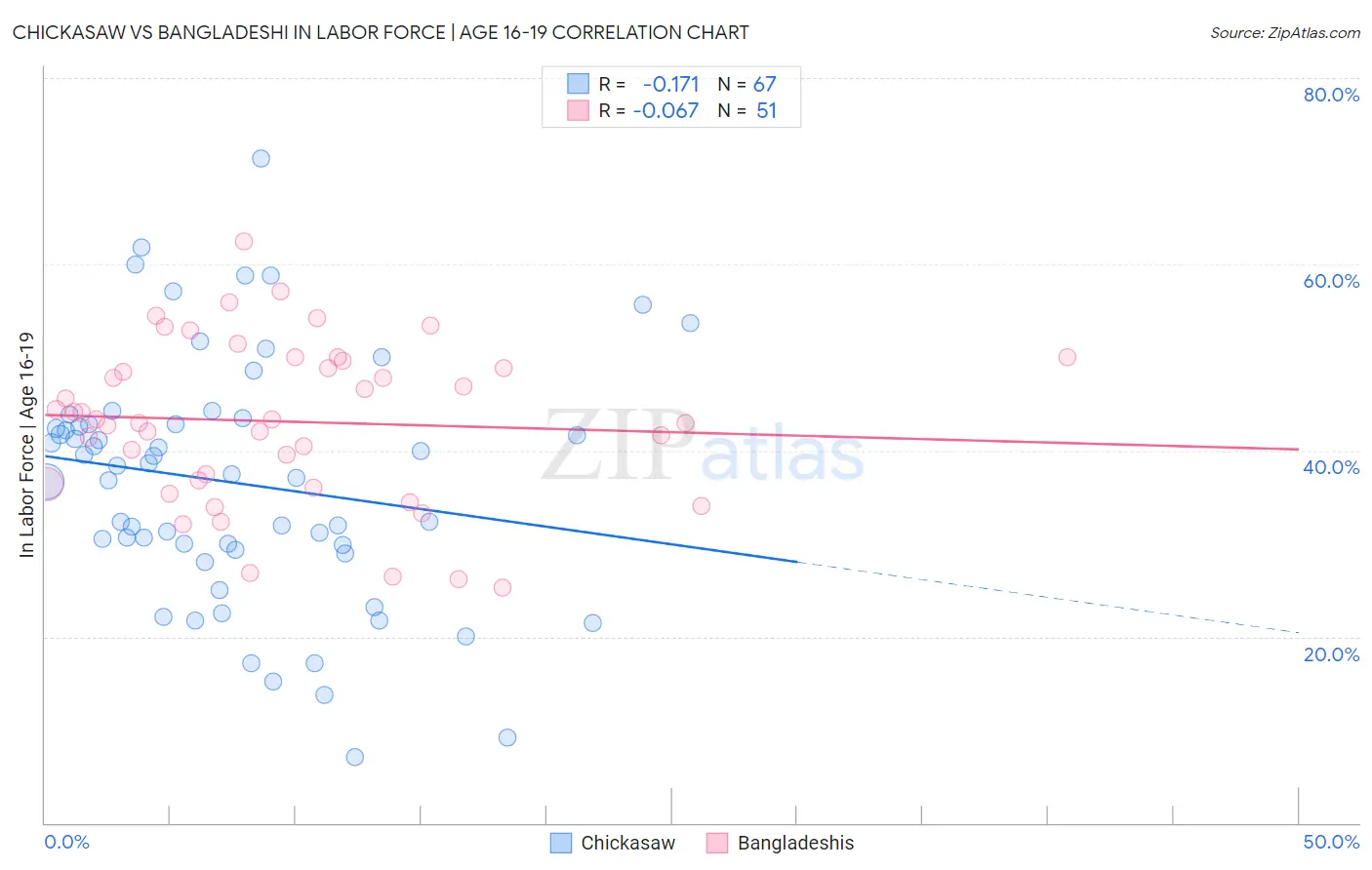Chickasaw vs Bangladeshi In Labor Force | Age 16-19
COMPARE
Chickasaw
Bangladeshi
In Labor Force | Age 16-19
In Labor Force | Age 16-19 Comparison
Chickasaw
Bangladeshis
38.3%
IN LABOR FORCE | AGE 16-19
97.8/ 100
METRIC RATING
117th/ 347
METRIC RANK
42.5%
IN LABOR FORCE | AGE 16-19
100.0/ 100
METRIC RATING
24th/ 347
METRIC RANK
Chickasaw vs Bangladeshi In Labor Force | Age 16-19 Correlation Chart
The statistical analysis conducted on geographies consisting of 147,579,210 people shows a poor negative correlation between the proportion of Chickasaw and labor force participation rate among population between the ages 16 and 19 in the United States with a correlation coefficient (R) of -0.171 and weighted average of 38.3%. Similarly, the statistical analysis conducted on geographies consisting of 141,415,826 people shows a slight negative correlation between the proportion of Bangladeshis and labor force participation rate among population between the ages 16 and 19 in the United States with a correlation coefficient (R) of -0.067 and weighted average of 42.5%, a difference of 10.8%.

In Labor Force | Age 16-19 Correlation Summary
| Measurement | Chickasaw | Bangladeshi |
| Minimum | 7.1% | 25.3% |
| Maximum | 71.4% | 62.5% |
| Range | 64.3% | 37.2% |
| Mean | 36.5% | 43.1% |
| Median | 37.5% | 43.3% |
| Interquartile 25% (IQ1) | 29.4% | 36.4% |
| Interquartile 75% (IQ3) | 42.8% | 49.6% |
| Interquartile Range (IQR) | 13.5% | 13.2% |
| Standard Deviation (Sample) | 13.1% | 8.6% |
| Standard Deviation (Population) | 13.0% | 8.5% |
Similar Demographics by In Labor Force | Age 16-19
Demographics Similar to Chickasaw by In Labor Force | Age 16-19
In terms of in labor force | age 16-19, the demographic groups most similar to Chickasaw are Immigrants from Nepal (38.3%, a difference of 0.010%), Assyrian/Chaldean/Syriac (38.3%, a difference of 0.030%), Colville (38.3%, a difference of 0.050%), Bulgarian (38.3%, a difference of 0.060%), and Ukrainian (38.3%, a difference of 0.11%).
| Demographics | Rating | Rank | In Labor Force | Age 16-19 |
| Maltese | 98.6 /100 | #110 | Exceptional 38.5% |
| Crow | 98.5 /100 | #111 | Exceptional 38.5% |
| Immigrants | Scotland | 98.5 /100 | #112 | Exceptional 38.5% |
| Sub-Saharan Africans | 98.3 /100 | #113 | Exceptional 38.4% |
| Hawaiians | 98.2 /100 | #114 | Exceptional 38.4% |
| Bulgarians | 97.9 /100 | #115 | Exceptional 38.3% |
| Colville | 97.9 /100 | #116 | Exceptional 38.3% |
| Chickasaw | 97.8 /100 | #117 | Exceptional 38.3% |
| Immigrants | Nepal | 97.8 /100 | #118 | Exceptional 38.3% |
| Assyrians/Chaldeans/Syriacs | 97.8 /100 | #119 | Exceptional 38.3% |
| Ukrainians | 97.6 /100 | #120 | Exceptional 38.3% |
| Ethiopians | 97.4 /100 | #121 | Exceptional 38.2% |
| Guamanians/Chamorros | 97.4 /100 | #122 | Exceptional 38.2% |
| Seminole | 96.7 /100 | #123 | Exceptional 38.1% |
| Immigrants | England | 96.4 /100 | #124 | Exceptional 38.1% |
Demographics Similar to Bangladeshis by In Labor Force | Age 16-19
In terms of in labor force | age 16-19, the demographic groups most similar to Bangladeshis are German Russian (42.4%, a difference of 0.080%), English (42.4%, a difference of 0.21%), Slovak (42.6%, a difference of 0.33%), Welsh (42.3%, a difference of 0.48%), and Polish (42.1%, a difference of 0.78%).
| Demographics | Rating | Rank | In Labor Force | Age 16-19 |
| Scandinavians | 100.0 /100 | #17 | Exceptional 43.6% |
| French Canadians | 100.0 /100 | #18 | Exceptional 43.6% |
| Belgians | 100.0 /100 | #19 | Exceptional 43.4% |
| Swiss | 100.0 /100 | #20 | Exceptional 43.3% |
| Ottawa | 100.0 /100 | #21 | Exceptional 43.0% |
| Sudanese | 100.0 /100 | #22 | Exceptional 42.9% |
| Slovaks | 100.0 /100 | #23 | Exceptional 42.6% |
| Bangladeshis | 100.0 /100 | #24 | Exceptional 42.5% |
| German Russians | 100.0 /100 | #25 | Exceptional 42.4% |
| English | 100.0 /100 | #26 | Exceptional 42.4% |
| Welsh | 100.0 /100 | #27 | Exceptional 42.3% |
| Poles | 100.0 /100 | #28 | Exceptional 42.1% |
| French | 100.0 /100 | #29 | Exceptional 42.1% |
| Scottish | 100.0 /100 | #30 | Exceptional 42.0% |
| Irish | 100.0 /100 | #31 | Exceptional 42.0% |